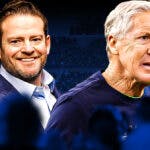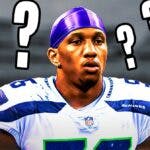The Seattle Seahawks were supposed to take a big step back during the 2018 season, but instead improved their record to 10-6 and made another playoff appearance, although they lost in the wild card round to the Dallas Cowboys. As long as Russell Wilson is under center, Seattle will be competitive, but in order to keep up with the Los Angeles Rams, the Seahawks must fill in some large holes this offseason, and specifically through the draft.
In order to determine what positions the team should target with the 21st overall pick, we need to map out a rough estimate of how free agency will go for Seattle. The Seahawks have over $50 million in cap space, but that doesn't mean they can afford to go on a spending spree.
Star pass-rusher Frank Clark is a free agent, and if Seattle can't agree to a long-term deal with Clark, they will be forced to use the franchise tag on him. Whatever happens with Clark, he should remain in a Seahawks uniform and make over $15 million this season. J.R. Sweezy, D.J. Fluker, and George Fant all played major roles on the offensive line last season, and are free agents as well. All-Pro safety Earl Thomas's relationship with the franchise has deteriorated to the point where there's virtually no chance he re-signs. Linebacker K.J. Wright is set to test the market, and could get a big payday from another team.

The Seahawks have the money to keep these players, but they must begin planning for the future as well. They can't spend much cash this offseason, because they will need plenty of it next year, when Jarran Reed, Bobby Wagner, and Russell Wilson will all need new contracts. Clark must be retained, and Sweezy, Fluker, and Fant shouldn't be too pricey, but it's probably best that Seattle lets Wright go so they can keep Wagner.
This leaves the team with a few needs heading into the draft, most notable offensive line, defensive line, linebacker, and secondary. Here are five prospects who would make big impacts for the Seahawks in 2019.
5. Rashan Gary, DL, Michigan
Gary may be the biggest wildcard of this draft class. He was hailed as a top draft prospect from the moment he committed to Michigan, and the hype surrounding him has yet to die down. At 6'5″ 280lbs, he has great size, and he is going to put on a show for the ages at the NFL Combine. He can play DT, DE, or EDGE, and with Seattle, he would likely play all three.
He has the versatility to dominate at all three positions, even though he never mastered one in college. For a player as naturally gifted as Gary, you would expect his production to be higher. He finished his college career with just 9.5 sacks, 3.5 of those coming in 2018. Yes, opposing offenses schemed to attempt to eliminate him, but the same can be said for other elite prospects like Myles Garrett, who still put up 8.5 sacks and 15 tackles for loss during his junior year.
Gary needs to be put in a position where he can play multiple roles and be coached well. Seattle has a penchant for utilizing defensive talent well, and putting Gary next to Jarran Reed inside or opposite of Frank Clark outside would give the ‘Hawks a terrifying defensive line.
4. Yodney Cajuste, OT, West Virginia
Last time Seattle took an offensive lineman in the first round (Germain Ifedi in 2016), things didn't go so well. Cajuste is a very different player from Ifedi, the biggest difference being Cajuste is a first-round prospect based on film and production rather than athletic potential.
He isn't perfect, and still has quite a few things to clean up regarding his hand technique, but he is already an excellent run blocker. Ifedi made strides in 2018 but the Seahawks must also begin preparing for life after Duane Brown; he will be 34 when the 2019 season begins and has plenty of tread on his tires. Cajuste could start over Ifedi at RT and then take over for Brown when the time comes.
3. Devin Bush, LB, Michigan
With Wright likely headed to a new team, a replacement is needed, and Bush would be a great fit. He is undersized at 5'11' 220lbs, but he more than makes up for it with his great speed, explosion, and effort. He can make plays from sideline-to-sideline, can diagnose running schemes instantly, and excels at shooting gaps.
His physicality sometimes gets the best of him, as his size doesn't allow him to disengage from blocks very well, but with a solid defensive line in front of him and Bobby Wagner beside him, that shouldn't be too much of an issue. Bush should end up being a great all-around linebacker who fits perfectly in the Seahawks' system.
2. Montez Sweat, EDGE, Mississippi State
Another pass-rusher, Sweat put up elite production during the past two seasons, finishing with 22.5 sacks and 30 tackles for loss. He has the potential to be the top pass-rusher for many teams, but in Seattle, he would be the Robin to Frank Clark's Batman, which would definitely benefit Sweat.
His hand usage is excellent and he has a very good understanding of the position. He possesses good explosiveness and knows how to limit the damage caused by his sub-par lateral mobility. He may not have the All-Pro potential of Gary, but Sweat is more of a sure thing, and that's what a playoff contender like Seattle needs.
1. Deionte Thompson, S, Alabama
With Earl Thomas and Kam Chancellor gone, it's time for Seattle to start looking for their next pair of great safeties. Tedric Thompson and Bradley McDougald were decent in 2018, but an upgrade is needed. Deionte Thompson struggled to end the season, but for most of the year, he looked like a legitimate top 20 player.
His speed, instincts, and ball skills give him All-Pro potential, but he will need to work hard in order to realize it. Thompson's biggest weakness is his discipline. He has excellent instincts, but oftentimes is torn between trusting them and taking a risk, or waiting back and assessing the situation methodically, which causes him to hesitate and miss a tackle, give up a big play down the seam, etc.
With proper coaching, Thompson can become a more assertive player. He's a willing tackler and good in run support, which means he has the potential to be a great single-high safety. By playing only free safety early in his career, Thompson's responsibilities can be reduced, allowing him to focus on what he does best; cover the field quickly and take away the deep ball.




